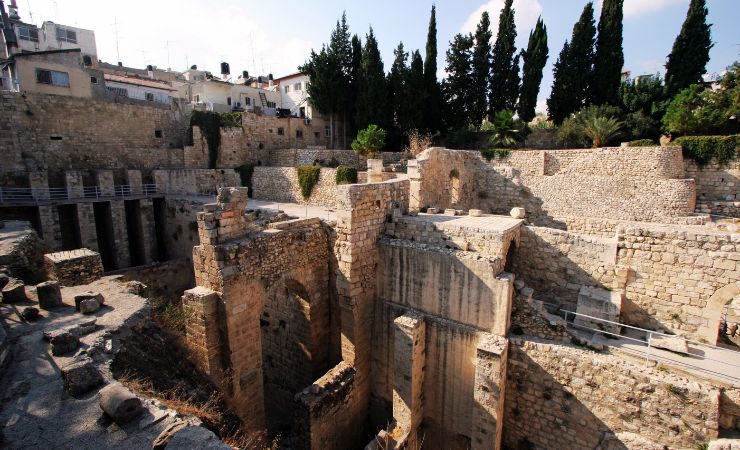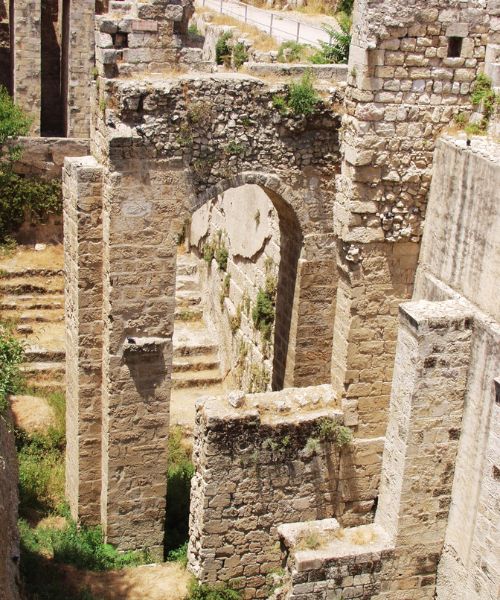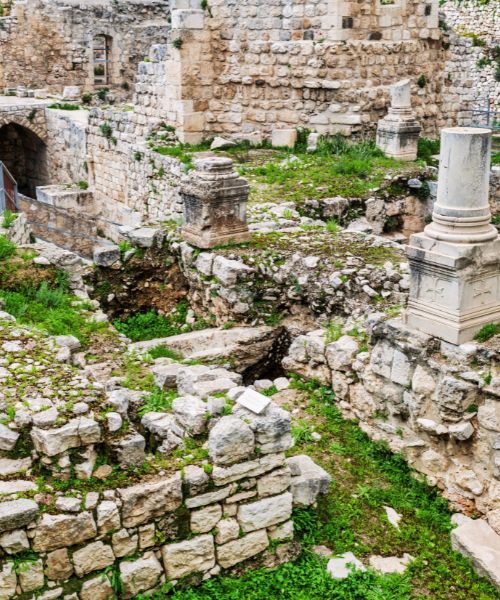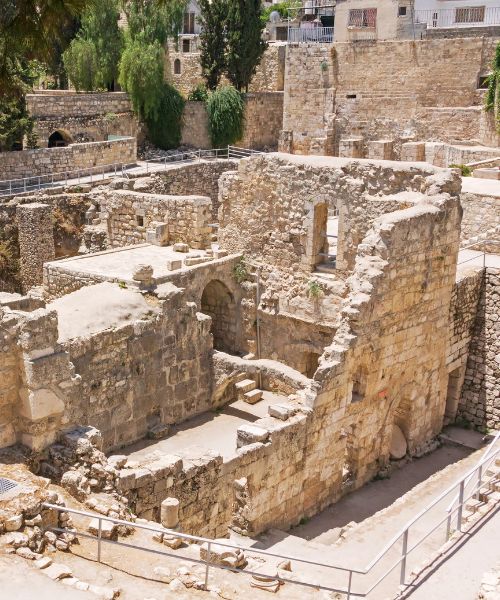The Pool of Bethesda: Where Jesus Healed the Ill
Introduction
Situated in Jerusalem’s Old City, the Pool of Bethesda are a testament to biblical times, particularly as the site of a notable miracle where Jesus heals the ill in the New Testament. The site is not to be confused with a site near the Sea of Galilee called Bethsaida.
Location
The Pool of Bethesda stand tall within the walled Old City, close to the Lion’s Gate and near the path of the Via Dolorosa.

Biblical Context of the Pool of Bethesda
The Pool of Bethesda was believed to have healing powers, an angel occasionally stirring the waters and whoever first entered the pool after such a disturbance was healed of whatever ailment they had. Among the multitudes of invalids around the pool, Jesus encounters a man who had been ill for 38 years. When Jesus learns of the man’s prolonged affliction, he asks him, “Do you want to be healed?”. The man explains his inability to reach the stirring waters in time. With compassion, Jesus declares, “Get up, take up your bed, and walk.”, and the man is healed instantly, carrying his bed and walking.
“When Jesus saw him lying there and learned that he had been in this condition for a long time, he asked him, ‘Do you want to get well?'”
“‘Sir,’ the invalid replied, ‘I have no one to help me into the pool when the water is stirred. While I am trying to get in, someone else goes down ahead of me.'”
“Then Jesus said to him, ‘Get up! Pick up your mat and walk.'”
“At once the man was cured; he picked up his mat and walked.
The Pool's Rich History
The Pool of Bethesda carry a rich history, dating back to the Second Temple period. The area initially served as a reservoir for rainwater, likely also being utilized as a mikveh, or ritual bath. Later, a 6-meter wide dam was built in its place. From the artificial pool, measuring 40×50 meters, water was transported to the Temple through conduits. It’s possible that this is the Upper Pool mentioned in the Book of Kings as “the upper pool.”
In the 1st century CE, the site found its way into the New Testament, specifically in the Book of John (John 5:1-15), where it was described as a healing sanctuary. It is here where Jesus is said to have healed a man who had been ill for 38 years.
After the destruction of the Second Temple, and especially following the building of Aelia Capitolina by Harian, a healing cult dedicated to the Greek god of medicine, Asclepius, seems to have emerged at the site, evidenced by the discovery of a Roman temple during archaeological excavations.
In the Byzantine period (330 CE to 1453 CE), the area underwent significant transformation. The healing narrative of Jesus at the Bethesda Pool was gaining prominence, making the site an important Christian landmark. A grand Byzantine church was built on the site, likely in the late 5th to early 6th century CE, to commemorate the miracle of healing. It was a complex structure with the pool included within its premises, indicating the continuity of the healing tradition.
The Persian invasion of Jerusalem in 614 CE likely led to the destruction of this Byzantine church. This invasion saw the destruction of many Christian sites, and while there isn’t specific evidence, it’s likely the Bethesda site wasn’t spared.
The early 12th century saw the arrival of the Crusaders, marking a new chapter for the site. The Crusaders identified the ruins at Bethesda as the home of Saint Anne, mother of the Virgin Mary. They built a large church church to commemorate the birth of the Virgin Mary, and a small chapel to commemorate the heading of the ill above the pool.
However, with Saladin’s conquest of Jerusalem in 1187 CE, the Crusader Kingdom fell. Saladin converted the Church of Saint Anne into an Islamic school, and destroyed the chapel above the pool.
The The Pool of Bethesda’s rediscovery in the 19th century led to its recognition as a significant archaeological site. Restoration works, particularly on the Church of Saint Anne, started under the French administration. Meanwhile, archaeologists unearthed remnants of the Byzantine church and the Roman temple, offering valuable insights into the site’s multi-layered past.



Sources and Additional Reading
Biblos Foundation – The Puzzling Pool of Bethesda
Wikipedia – Pool of Bethesda
JesusWalk
Nearby Sites
-
Lion’s Gate: This one of the eight gates of the Old City. It is named for the pair of lion figures carved into its façade. The gate is the starting point for the Via Dolorosa.
-
Church of Flagellation: This Roman Catholic church is traditionally believed to be the spot where Jesus was scourged by Roman soldiers before his crucifixion. Next to it is the Church of the Condemnation and the Imposition of the Cross.
-
Ecce Homo Arch: Tradition holds that it’s the place where Pontius Pilate presented Jesus to the crowds with the words “Ecce Homo” meaning “Behold the Man”.
-
Sisters of Zion Monastery: This 19th-century monastery includes a fascinating underground area where visitors can see remnants of the Antonia Fortress, a military barracks built by Herod the Great.



